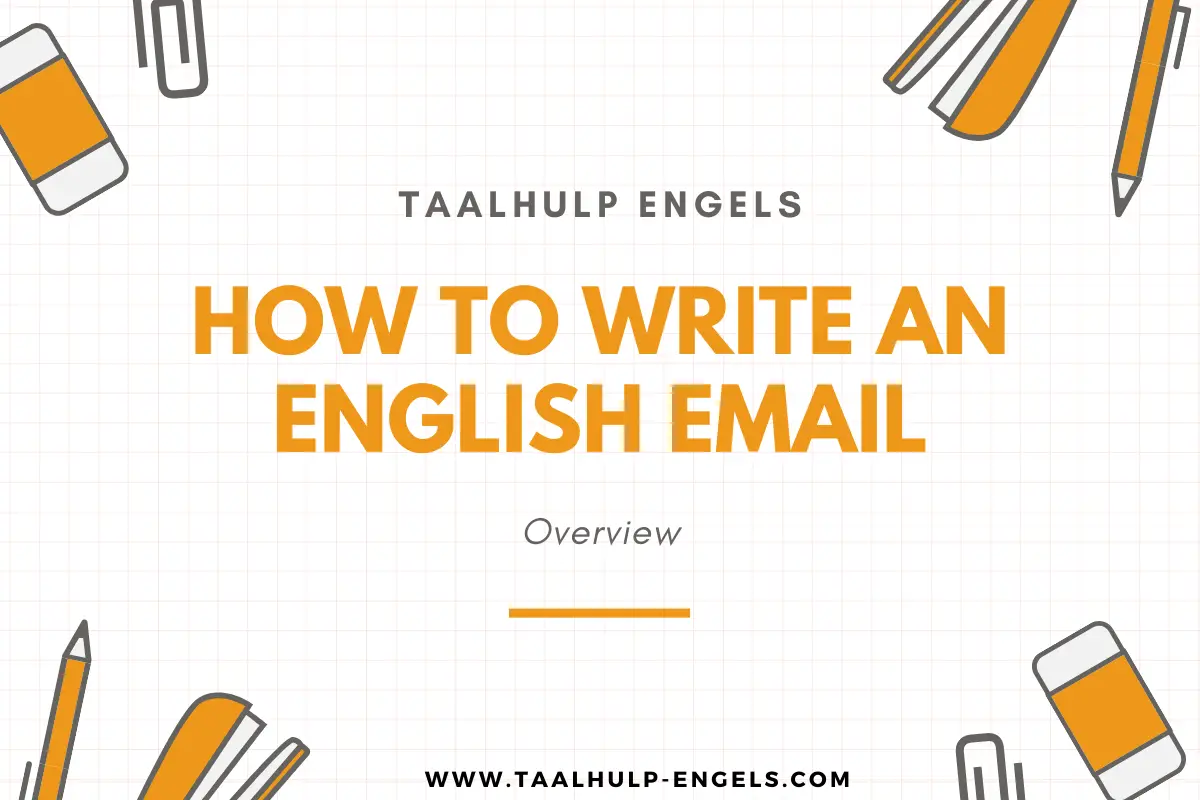Nowadays almost everything happens on social media, but there are still a number of situations when you need to write an email. A classic example is when you want to apply for a job. In most cases, you need to write an email (or even a letter) to a particular company before you can go over there and have a conversation.
That is why it’s important that you do not lose the skill of writing the perfect email. You might think you won’t need it anymore, but this is definitely not the case.
In this article, you have an overview of how you can write a good English email and which steps you need to follow. Every English email needs to have at least three elements: a greeting, content and a closing/signature.
Deciding on the formality: formal or informal English email
The first step you need to take when you want to write an English email is thinking about the formality. Do you want to write a formal or informal email? The difference between these two mostly comes down to how well you know the recipient. If you are writing someone you don’t know (that well) or to your boss, for example, you should go for a formal email. If you are sending an email to a good friend or someone you know well, an informal email would be the best choice.
Formal email
When you want to send an email to a superior or someone you don’t really know, it’s best to write a formal email. Once you know this, you can start writing the email itself. Below, you have a detailed overview of which elements should be in your formal English email.
Greeting in a formal email
The first step in the process of writing the perfect English email is greeting the reader in the right way. If you choose to write a formal email, there are multiple ways to start. Usually, a formal email starts with ‘Dear’, and what follows depends on whether you know the name of the recipient or not.
After ‘Dear’, you put the title that is appropriate for the person you’re addressing. You have some examples below of the most common ones.
| Mr, Sir |
| Ms, Madam |
| Miss |
| Mrs |
Next, you put the last name of the person you’re addressing (if you know his/her name). This should look something like this:
Dear + Mr, Ms, Sir, Madam, … + last name
If you don’t know the name, you just use the title. It should look like this:
Dear + Mr, Ms, Sir, Madam, …
There are multiple possibilities to form the correct greeting, depending on the context and the recipient of the email. Some structures are used very frequently because they can be used in a number of situations. You have an overview of the most used ones below:
| Dear Sir |
| Dear Mr Daniels |
| Dear Madam |
| Dear Miss Marple |
| Dear Sir, Madam |
| Dear Mrs Wilson |
| Dear Ms Haas |
| To whom it may concern Dear reader |
Note: ‘To whom it may concern’ is very formal and is not used that often. You should only use it when you have no idea who will read the email and when it’s really formal. ‘Dear reader’ is a bit less formal.
Content of a formal email
After using the right greeting, it’s also important that you use the right structures to make sure the message is clear. There are a couple of structures you can use to make sure the recipient knows what you are talking about.
It’s common to write an introductory sentence about the reason you’re sending the email. This is not always the case but is usually done to ‘prepare’ the reader for what is coming next. In this sentence, you could also write an apology or something like that. You can find some examples below:
| Thank you for your email. |
| In reply to your email … |
| As you requested … |
| I would like to kindly remind you that … |
| Your credentials were given to me by … |
| I’m writing with regard to … |
| Further to our conversation … |
| I am sorry to inform you that … |
| Thank you for your quick reply. |
After the introductory sentence, you should write the actual message of your English email. There are a lot of different sentences you can use, but this really depends on what you want to say.
Once the message is clear, there are a couple of things you could say or ask towards the end of your email. You can see some examples below.
| Could you please … |
| I’m interested in … |
| As requested |
| Feel free to contact me if you have any further questions. |
| I will contact you again shortly. |
| Thank you for your invitation. |
| I wonder if you could … |
| I wonder if it is possible … |
| Attached you will find … |
Ending a formal email
Once you’ve said what you wanted to say, you should also end your English email in the right way. There are also a lot of possibilities to do this in the appropriate way and below you have some examples of sentences that are commonly used.
| Thank you for your help in this matter. |
| I apologize for any inconvenience. |
| I’m looking forward to … |
| I’m looking forward to the possibility of working together. |
| Please reply as soon as possible because … |
Signature in a formal email
The final thing you need to do before sending is putting your signature at the end of the email. You should use one of the following closing words, followed by your full name on the next line, especially when you don’t know the recipient.
| Yours faithfully |
| Yours sincerely |
| Kind regards |
| Best regards |
Personal and informal email
If you want to send an email to someone you know well, it’s evident that this email will be different from the one you would send to your boss. The tone is less formal because you know the recipient (fairly) well. This implies that there are even more ways to write a good email. It’s less strict which structures you should use because it’s not as important.
Greeting in a personal and formal email
Writing an informal and personal email means that you know the person rather well. That’s why you use a less formal and more personal greeting.
These greetings are informal but have similarities with formal greetings. Usually, you need two parts: a greeting and the first name of the person you’re addressing. It should look something like this:
Dear + Luke
‘Dear’ is also used for informal greetings, as you can see. The main difference is that you use the first name, instead of the full name. You know the recipient well, so it’s more natural to address him/her by using the first name.
Of course, there are other ways to start your informal email. Take a look at the following examples:
| Dear Luke |
| Hi Matthew |
| Hey Joey |
In essence, these greetings are similar to formal ones. The main difference here is that you use the first name of the recipient.
Content of a personal and informal email
There are a lot of things you could mention in a personal and informal email, but some things are best mentioned at the beginning of your email. Just like a formal email, the beginning of an informal email should say why you are sending the email or what the email will be about. You could also ask how he/she is doing, for example. You have some example sentences below:
| How are you (doing)? |
| Thank you for your present. |
| I am happy to hear from you again. |
| Thank you for your message. |
| I’m sending this email to see how you are doing / holding up. |
| I’m writing this email to … |
In addition to the sentences above, there are some other structures you can use. Of course, it all depends on what you want to say, but the examples below are commonly used in informal and personal emails.
| I’m happy to hear that … |
| Do you know what I have just discovered? |
| Let me know what you think about it. |
| I have (some) good news. |
| Did you know that … ? |
Ending a formal email
At the end of your email, you could use one of the following sentences to end your email in the appropriate way. These sentences are usually not really related to the content of your email, but they are used to show affection and make it a bit more personal.
| I cannot wait to see you again. |
| I have missed you so much in the last few months. |
| See you next week! |
| I hope you are doing well. |
| Please give my regards to … |
| Please say hello to … from me. |
Signature in an informal and personal email
You should also end an informal and personal English email in the right way. You can use one of the expressions below, followed by your name on the next line. Most people only use their first name here, but it’s up to you.
| Bye |
| Regards |
| Cheers |
| All the best |
| Best wishes |

